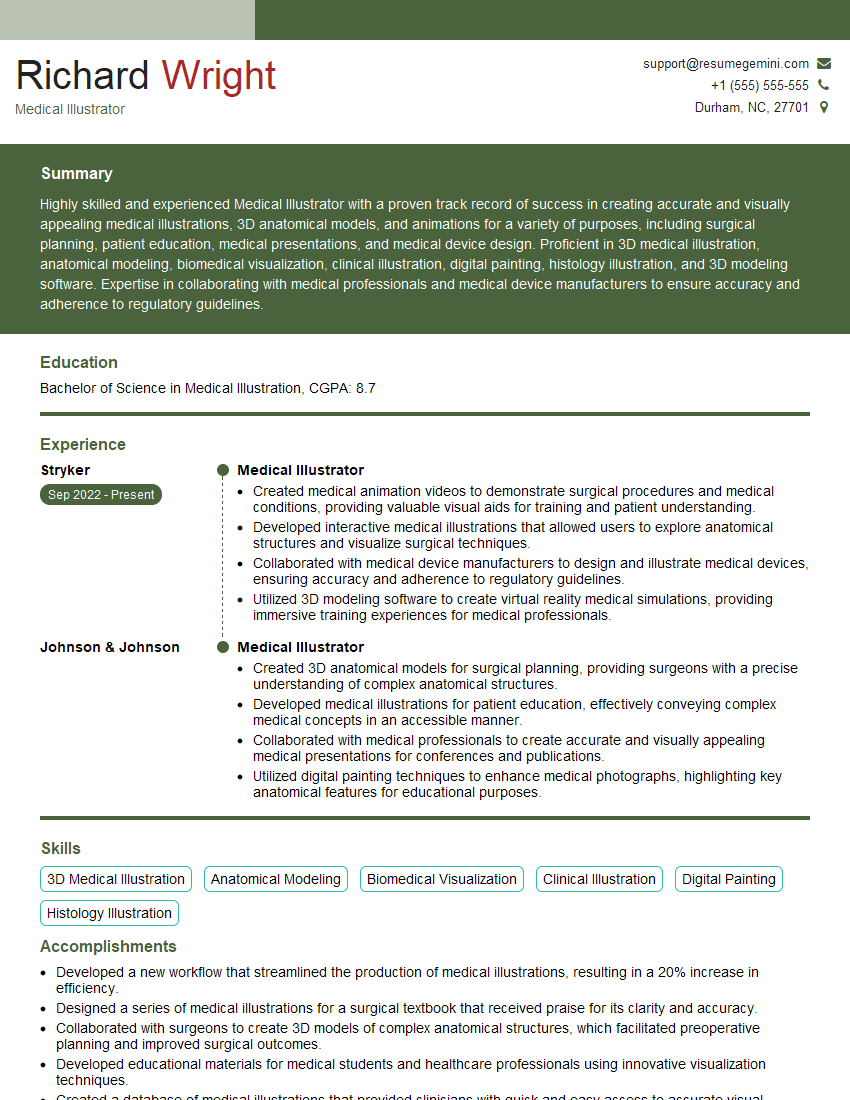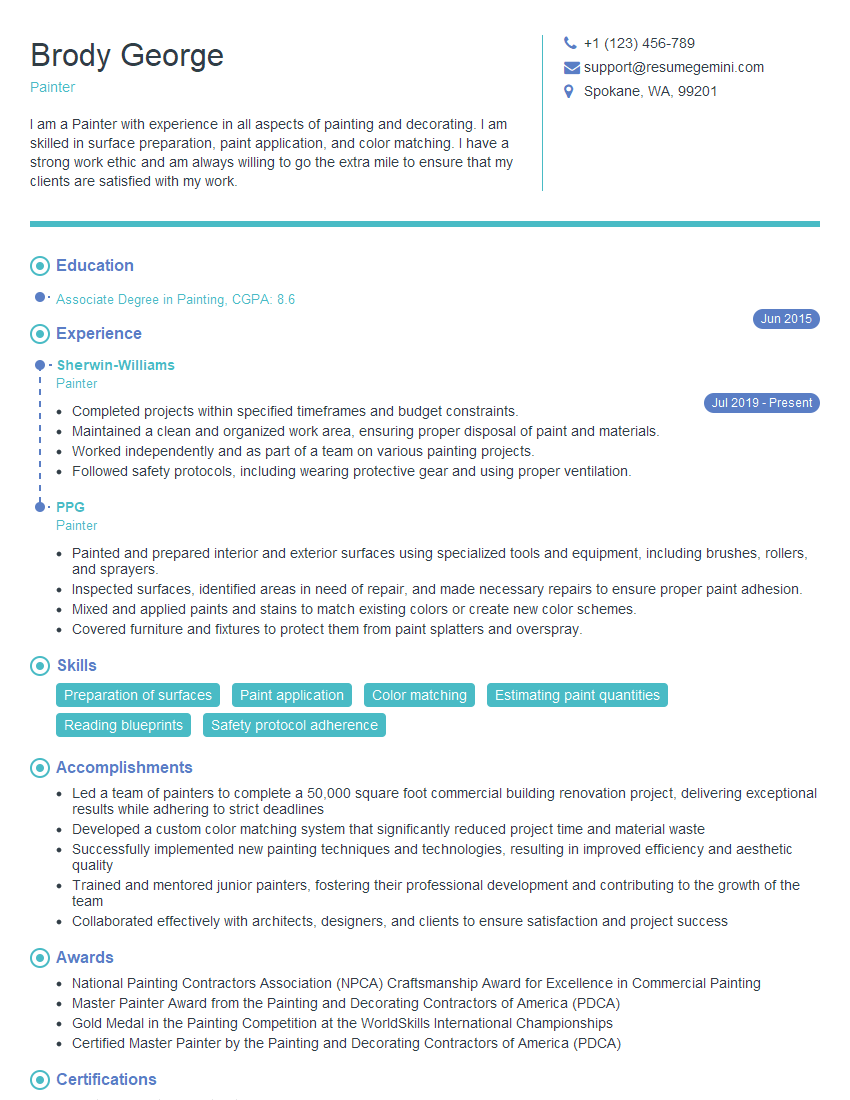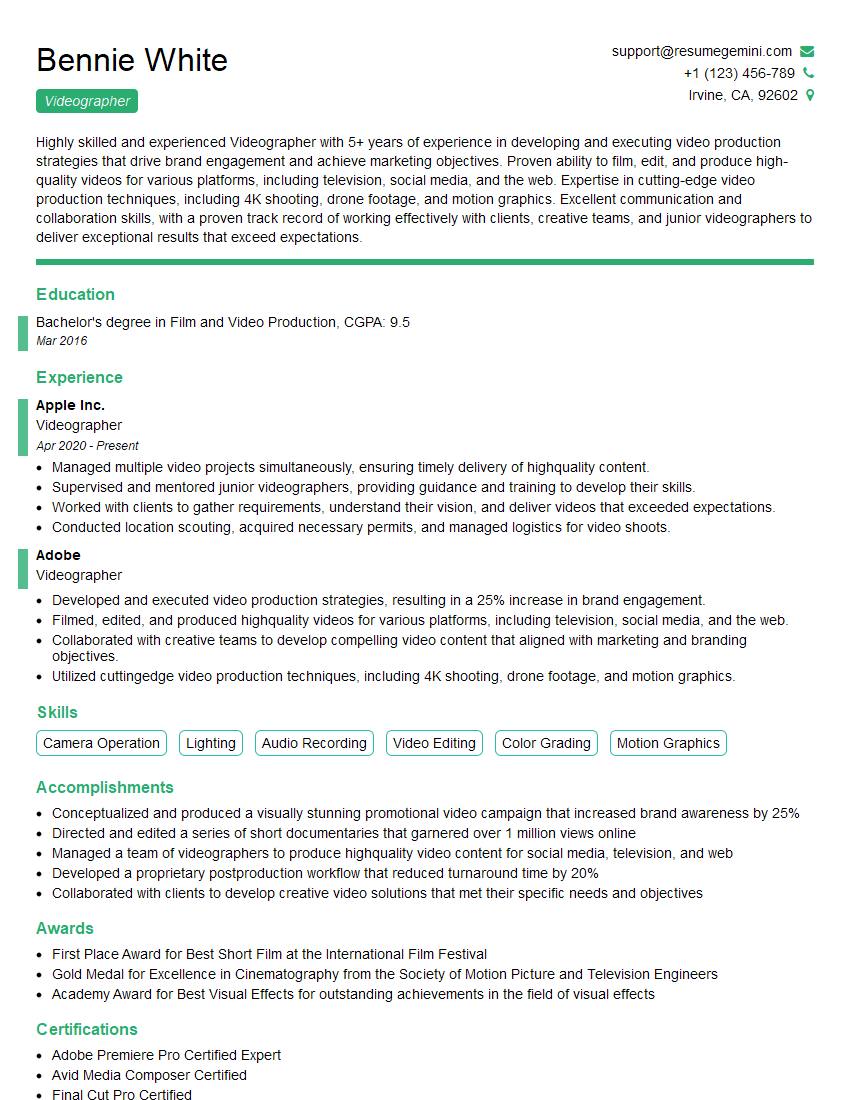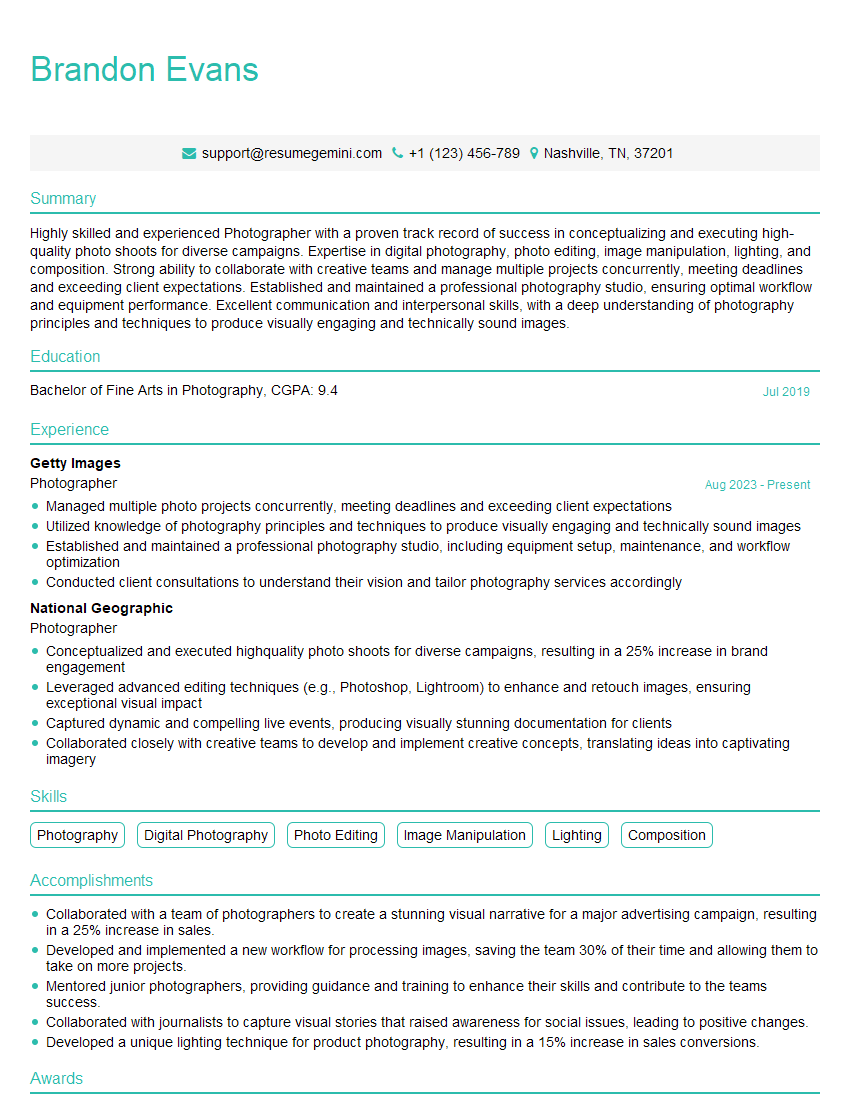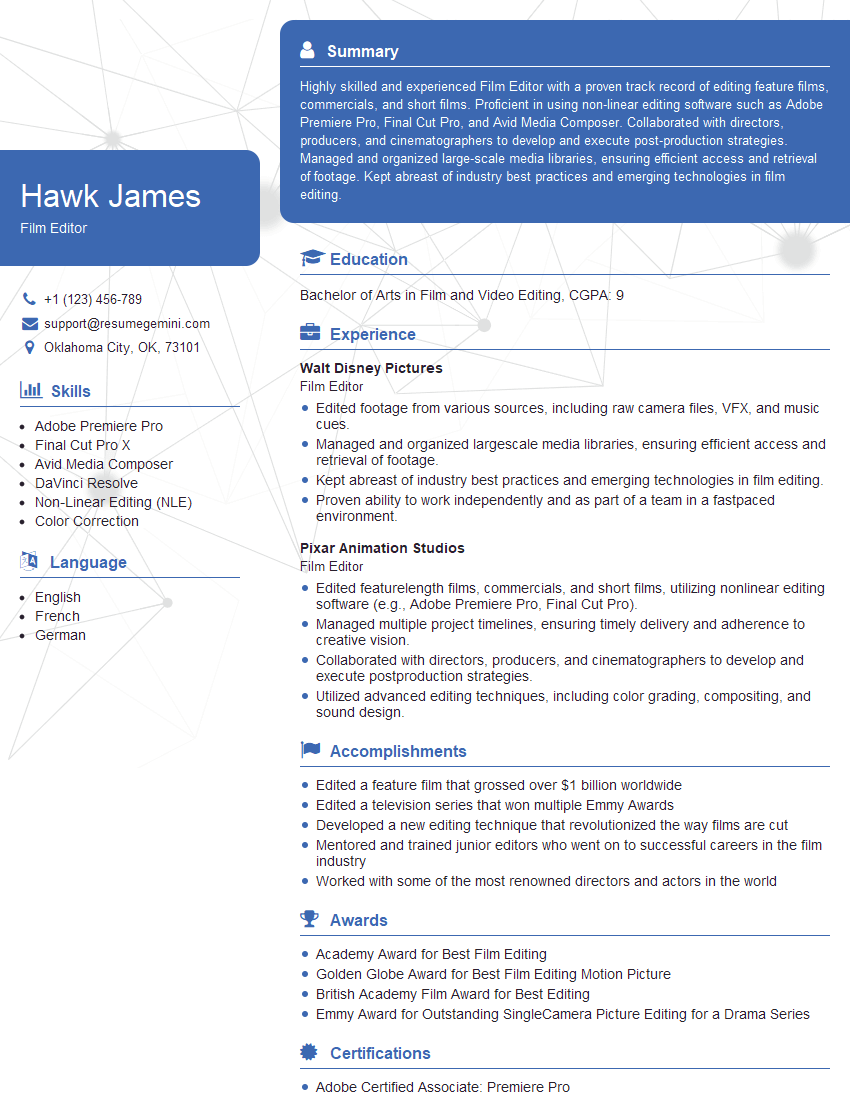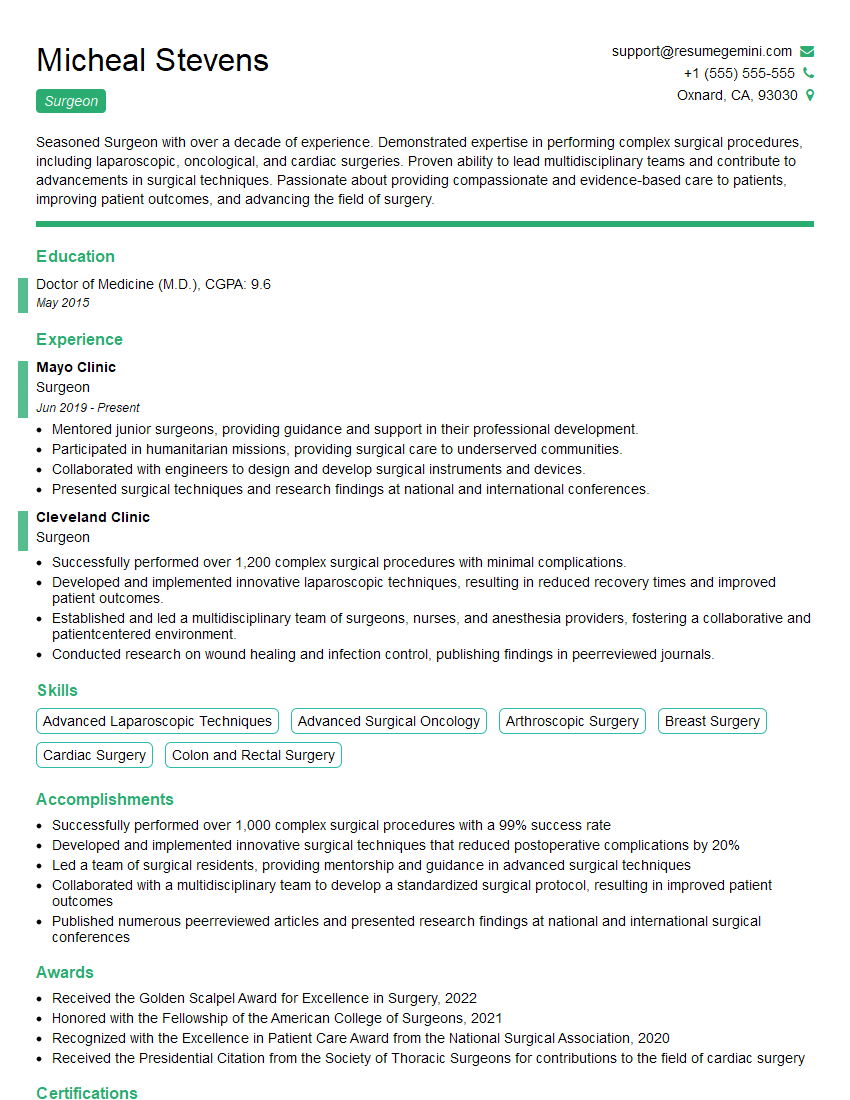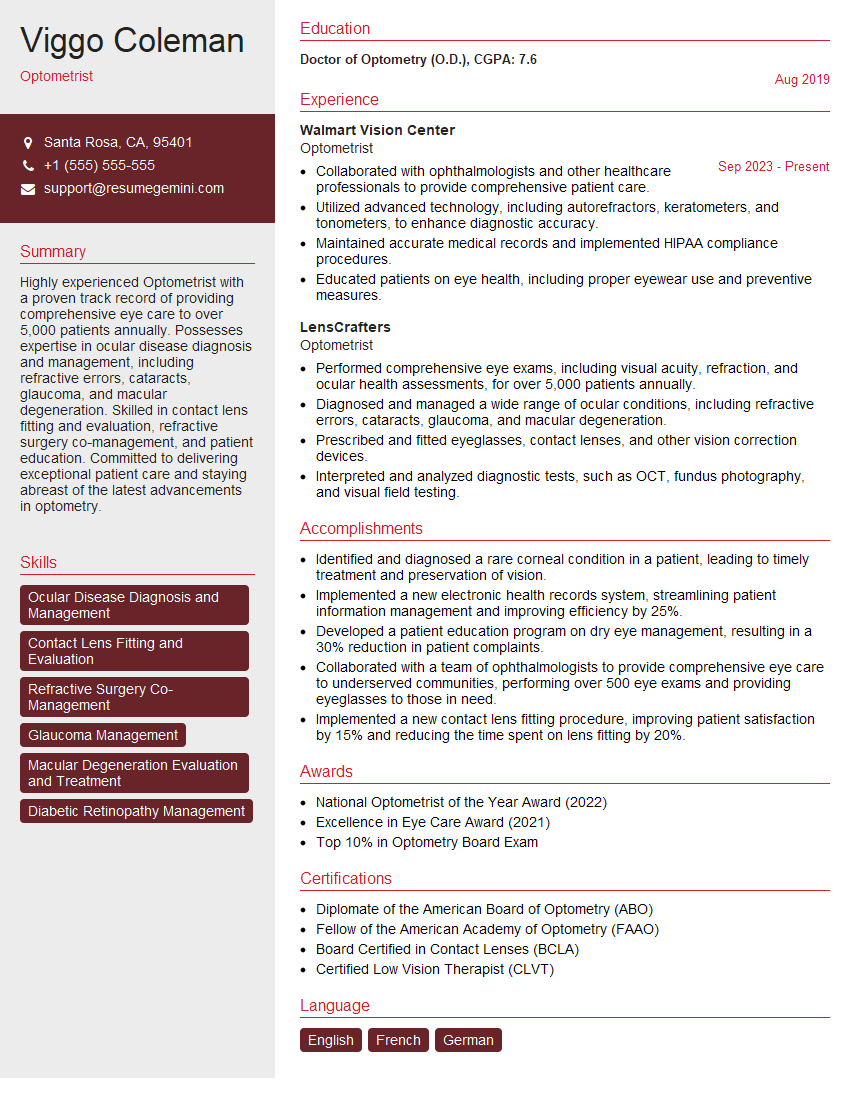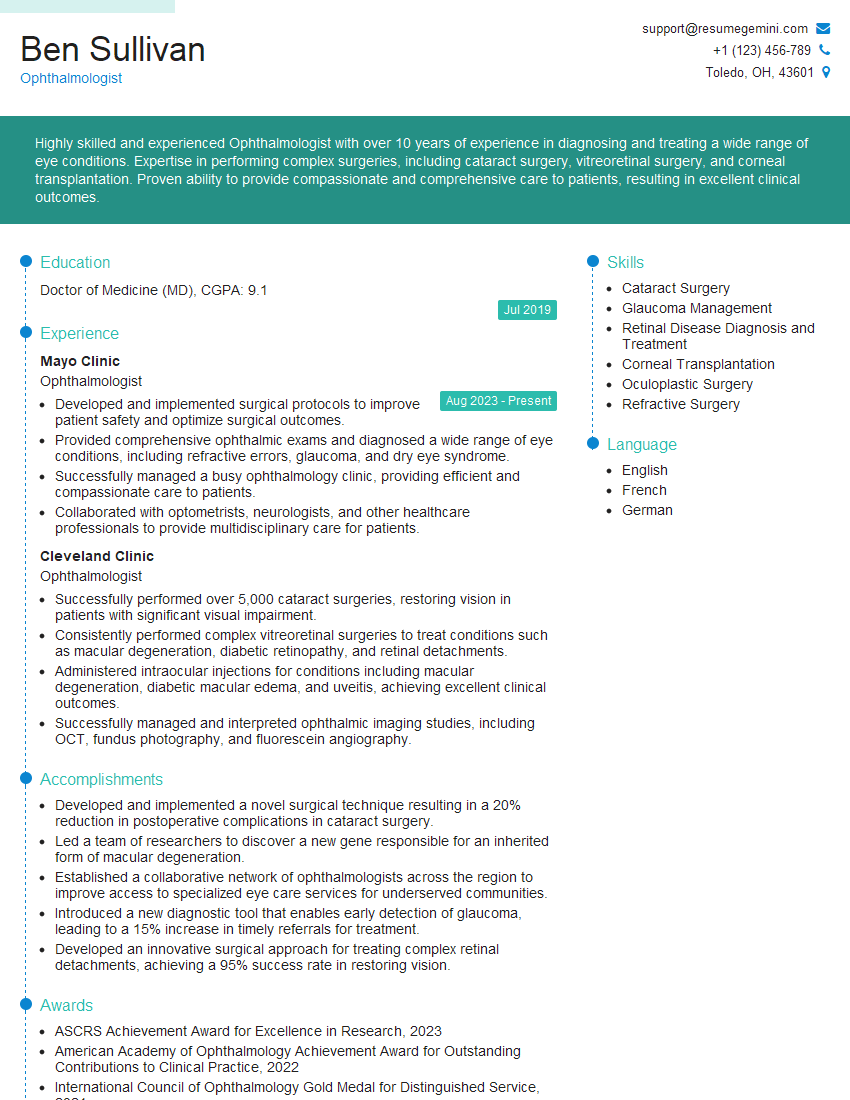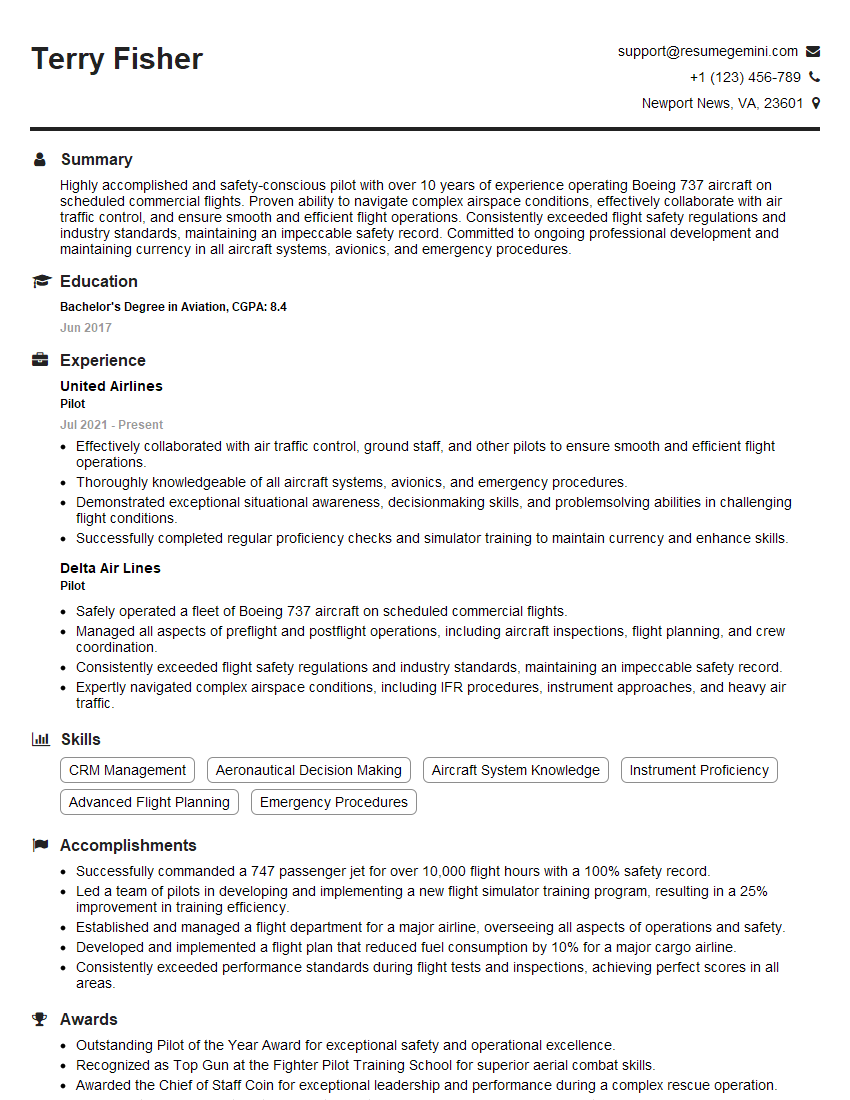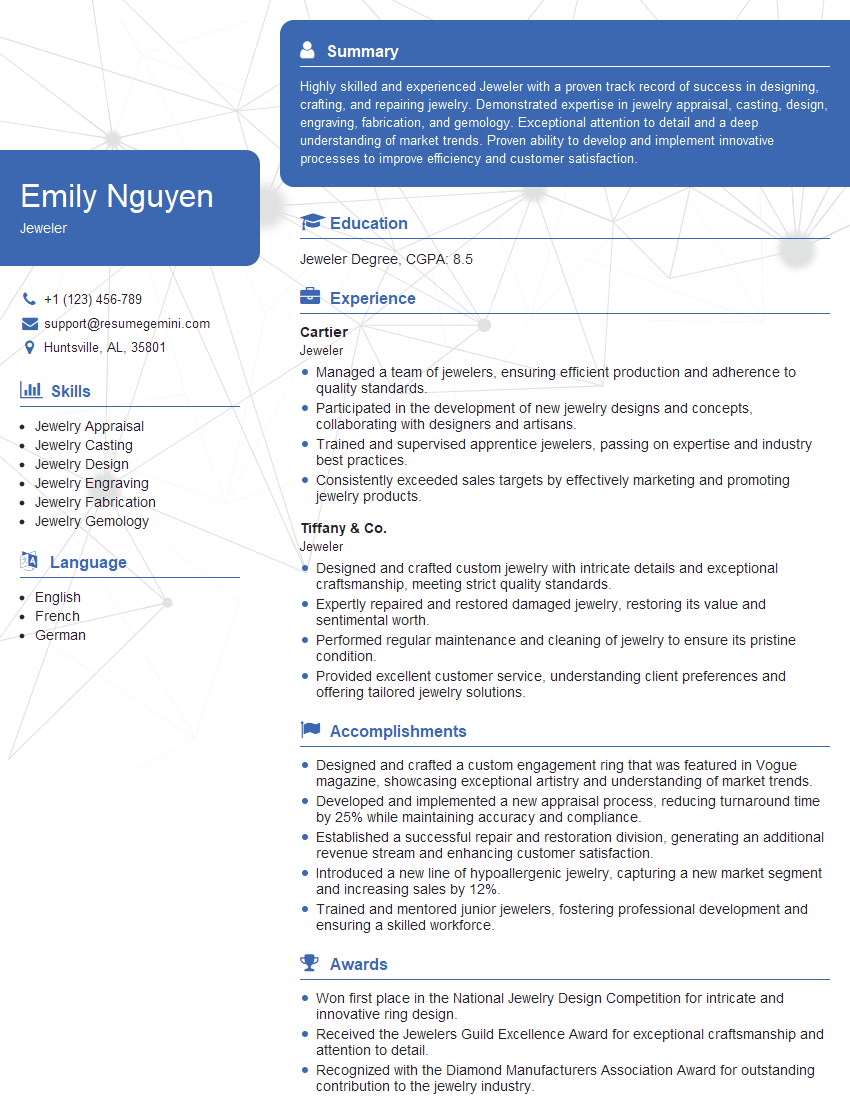The thought of an interview can be nerve-wracking, but the right preparation can make all the difference. Explore this comprehensive guide to Excellent Visual Acuity and Color Vision interview questions and gain the confidence you need to showcase your abilities and secure the role.
Questions Asked in Excellent Visual Acuity and Color Vision Interview
Q 1. Explain the difference between visual acuity and visual field.
Visual acuity and visual field are two distinct aspects of vision, often confused. Visual acuity refers to the sharpness of vision, essentially how clearly you see detail at a specific distance. Imagine trying to read the letters on an eye chart – that’s a test of your visual acuity. Visual field, on the other hand, describes the entire area you can see while looking straight ahead, without moving your eyes or head. Think of it as the panoramic view in front of you. A person might have excellent visual acuity (sharp central vision), but a limited visual field (difficulty seeing things peripherally, or to their sides).
To illustrate the difference: Someone with macular degeneration might have poor central visual acuity (difficulty seeing things directly in front of them), but their peripheral vision (visual field) may be largely unaffected. Conversely, someone with glaucoma may retain good visual acuity, but experience a shrinking visual field, losing their side vision gradually.
Q 2. Describe the Snellen chart and its use in assessing visual acuity.
The Snellen chart is the most common tool for assessing visual acuity. It’s that familiar chart with progressively smaller rows of letters. Each letter’s size corresponds to a specific visual angle, representing the ability to resolve detail at various distances. A person stands 20 feet from the chart, and the smallest row they can correctly read determines their visual acuity. For example, 20/20 vision means the person can see at 20 feet what a person with ‘normal’ vision can see at 20 feet. 20/40 vision indicates that the person needs to be 20 feet away to see what a person with normal vision can see at 40 feet – indicating reduced acuity.
The Snellen chart is a simple, standardized test, easy to administer, and provides a quantifiable measure of visual acuity. However, it’s important to note that it primarily tests central vision and doesn’t account for other aspects of visual function, like peripheral vision or color perception.
Q 3. What are the common causes of impaired visual acuity?
Impaired visual acuity has numerous causes, ranging from refractive errors to severe eye diseases. Common causes include:
- Refractive errors: Myopia (nearsightedness), hyperopia (farsightedness), and astigmatism (blurred vision due to an irregularly shaped cornea). These are often correctable with eyeglasses or contact lenses.
- Cataracts: Clouding of the eye’s lens, leading to blurry vision. Cataract surgery is usually very effective.
- Glaucoma: Damage to the optic nerve, often due to increased pressure within the eye. Early detection and treatment are crucial to prevent vision loss.
- Macular degeneration: Deterioration of the macula, the central part of the retina responsible for sharp, central vision. Age-related macular degeneration is a common cause of vision loss in older adults.
- Diabetic retinopathy: Damage to the blood vessels in the retina caused by diabetes. Strict blood sugar control can help prevent or slow the progression.
- Amblyopia (lazy eye): Reduced visual acuity in one eye due to abnormal development during childhood.
It’s crucial to remember that early detection and intervention are key in managing many of these conditions. Regular comprehensive eye exams are highly recommended.
Q 4. Explain the concept of color vision deficiency and its types.
Color vision deficiency, often called color blindness, is the inability to distinguish certain colors accurately. It’s primarily caused by genetic defects affecting the cone cells in the retina, responsible for color vision. There are several types:
- Red-green color blindness: The most common type, affecting primarily the ability to distinguish between shades of red and green. This can range from mild difficulty to complete inability to differentiate these colors.
- Blue-yellow color blindness: Less common than red-green color blindness, it involves difficulty distinguishing between blue and yellow hues.
- Total color blindness (monochromacy): A very rare condition where individuals see only shades of gray; they lack functional cone cells.
It’s important to note that ‘color blindness’ is a misnomer, as most individuals with color vision deficiency can still see colors, but their perception is altered. The severity varies greatly between individuals.
Q 5. Describe the Ishihara test and its purpose.
The Ishihara test is a widely used and reliable method for assessing color vision deficiency. It consists of a series of colored plates, each containing a number or pattern embedded within a background of similar-colored dots. Individuals with normal color vision can easily identify the numbers or patterns, while those with color vision deficiencies may see different numbers or be unable to identify them at all.
The test is simple, quick, and provides a preliminary assessment. If a color vision deficiency is suspected based on the Ishihara test, further, more comprehensive testing might be necessary to determine the exact type and severity of the deficiency. The test is primarily used for screening purposes and not for detailed diagnosis.
Q 6. How does age affect visual acuity and color perception?
Age significantly impacts both visual acuity and color perception. As we age, the lens of the eye loses its elasticity, making it harder to focus on nearby objects (presbyopia). This contributes to a gradual decline in visual acuity. The retina and other eye structures also undergo changes with age, further affecting visual sharpness. Moreover, the ability to distinguish certain colors, particularly blues and greens, may gradually diminish with age due to changes in the cone cells.
These age-related changes are generally gradual and can be managed with corrective lenses, lifestyle modifications, and sometimes medication. Regular eye exams are vital for early detection and management of age-related vision changes.
Q 7. What are the potential occupational hazards related to poor visual acuity?
Poor visual acuity presents several occupational hazards, varying significantly depending on the profession. Here are some examples:
- Increased risk of accidents: In professions requiring precise movements or operating machinery (e.g., construction workers, pilots, drivers), poor visual acuity can drastically increase the risk of accidents and injuries.
- Reduced productivity: In jobs requiring detailed visual work (e.g., surgeons, graphic designers, inspectors), impaired vision can decrease productivity and the quality of work.
- Strain and fatigue: Constant straining to see clearly can lead to eye strain, headaches, and general fatigue.
- Difficulty performing tasks: Many jobs require specific visual skills; for instance, a machinist with poor visual acuity may have difficulty aligning parts or reading measurements accurately.
Employers have a responsibility to ensure that their employees have adequate vision for their job. This may include pre-employment vision testing, regular eye exams, and providing appropriate visual aids where necessary.
Q 8. How can visual acuity be improved or corrected?
Visual acuity, or sharpness of vision, can be improved or corrected depending on the underlying cause. Refractive errors like myopia (nearsightedness), hyperopia (farsightedness), and astigmatism (blurred vision) are commonly corrected with corrective lenses – eyeglasses or contact lenses. These lenses refract light correctly to focus it sharply on the retina, improving image clarity. For more severe cases, refractive surgery such as LASIK or PRK can permanently reshape the cornea to correct refractive errors. In cases of cataracts (clouding of the eye’s lens), surgical removal of the clouded lens and implantation of an artificial lens is necessary to restore clear vision. Certain eye diseases may also affect visual acuity; treatment depends on the specific disease and can involve medications, laser therapy, or surgery.
Think of it like adjusting a camera lens. If the lens is misaligned, the image is blurry. Corrective lenses or surgery essentially realign the ‘lens’ of your eye to ensure a clear and sharp image.
Q 9. Describe different methods for assessing color vision.
Several methods are used to assess color vision, ranging from simple screening tests to more comprehensive evaluations. The most common screening test is the Ishihara Color Test, which uses a series of colored plates with embedded numbers or shapes. Individuals with normal color vision can easily identify these figures, while those with color vision deficiencies may struggle. More comprehensive tests include the Farnsworth-Munsell 100-Hue Test, which assesses the ability to discriminate between subtle variations in color hue, and the Nagel Anomaloscope, a device that allows for precise quantitative measurements of color perception. These tests are crucial for diagnosing various forms of color blindness, such as red-green or blue-yellow deficiencies.
Imagine a painter needing to match precise shades of paint. These tests assess the individual’s ability to accurately distinguish those subtle variations in color.
Q 10. Explain the role of cones and rods in visual acuity and color perception.
Rods and cones are photoreceptor cells in the retina responsible for vision. Rods are highly sensitive to light and function primarily in low-light conditions, contributing to our night vision and peripheral vision. They do not contribute to color vision. Cones, on the other hand, are responsible for color vision and visual acuity in bright light. There are three types of cones, each sensitive to a different range of wavelengths (red, green, and blue), allowing us to perceive a wide spectrum of colors. The concentration of cones is highest in the fovea, the central area of the retina, which is responsible for our sharpest vision. Visual acuity depends largely on the proper functioning of cones and the clarity of the retinal image focused upon them. Color perception entirely relies on the cones’ ability to differentiate wavelengths of light.
Think of rods as the night-vision mode of your eye, while cones are the high-definition color mode. Both are essential for a complete visual experience.
Q 11. How do you interpret a visual acuity chart?
A visual acuity chart, like the Snellen chart, displays rows of letters of decreasing size. The patient stands a standard distance (usually 20 feet) from the chart and reads the smallest line they can discern. The notation used, such as 20/20, represents the distance at which the patient can read the line (20 feet) compared to the distance at which a person with normal vision can read the same line (also 20 feet). A score of 20/40 indicates that the patient can read at 20 feet what a person with normal vision can read at 40 feet; this suggests reduced visual acuity. Other charts use symbols or pictures for testing young children or non-readers. The interpretation involves comparing the patient’s ability to see at a specific distance to the standard, providing a quantitative measure of their visual acuity.
It’s a simple yet powerful method to objectively assess how well someone sees at a distance.
Q 12. What are the implications of color blindness in various professions?
Color blindness can have significant implications in various professions. For instance, in aviation, pilots need to accurately distinguish colors of lights and signals; color blindness can severely impair their ability to do so safely. Similarly, in healthcare, accurate color discrimination is crucial for interpreting medical images and conducting certain procedures. Professionals in fields like graphic design, painting, or fashion design also require precise color perception. Even professions seemingly unrelated, such as electrical engineering (distinguishing colored wires), may necessitate proper color vision. The implications depend on the severity of the deficiency and the specific demands of the profession.
It’s essential for employers to be mindful and make reasonable accommodations to ensure workplace safety and inclusivity for color-blind individuals.
Q 13. How can you adapt your workflow to accommodate individuals with visual impairments?
Adapting workflows for visually impaired individuals necessitates understanding their specific needs and limitations. This may involve providing large-print materials, using screen readers or screen magnification software on computers, adjusting lighting for optimal contrast, using auditory cues instead of visual ones, and ensuring accessible physical layouts (e.g., clear pathways, avoiding obstacles). Training colleagues on appropriate communication strategies is vital. Moreover, utilizing assistive technologies like voice recognition software, tactile feedback devices, and braille keyboards can significantly improve productivity and access to information. Regular consultation with the individual to understand their evolving needs is key to ensuring a supportive and productive environment.
It’s about creating an inclusive environment where everyone can participate effectively.
Q 14. Describe the process of diagnosing and managing color vision deficiencies.
Diagnosing color vision deficiencies involves conducting the tests described earlier. The Ishihara test serves as a quick screening tool, while more detailed tests like the Farnsworth-Munsell or Nagel Anomaloscope are used for a precise diagnosis and to classify the type and severity of the deficiency. Management typically focuses on providing adaptive strategies and assistive technologies to minimize the impact of the deficiency on daily life and professional activities. There is currently no cure for most forms of color blindness, but appropriate accommodations can greatly enhance function and quality of life. This might include specialized software for color discrimination, colored contact lenses in some cases, or specific training in color identification techniques.
Early diagnosis allows for timely adaptation and mitigation of potential challenges.
Q 15. What are the different types of corrective lenses and their impact on visual acuity?
Corrective lenses are designed to compensate for refractive errors, improving visual acuity. The type of lens depends on the specific refractive error.
- Spectacles (Eyeglasses): These are the most common type. They use lenses to refract (bend) light, focusing it correctly on the retina. For example, concave lenses correct myopia (nearsightedness) by diverging light rays before they reach the eye. Convex lenses correct hyperopia (farsightedness) by converging light rays.
- Contact Lenses: These lenses sit directly on the surface of the eye, offering a more cosmetically appealing and often clearer vision than eyeglasses. They come in various types, including soft lenses (most common), rigid gas permeable lenses (for astigmatism or irregular corneas), and scleral lenses (for severe conditions).
- Intraocular Lenses (IOLs): These are surgically implanted lenses, typically used after cataract surgery. They permanently correct refractive errors and improve vision. The type of IOL used will depend on the patient’s needs and the surgeon’s recommendations.
The impact on visual acuity is significant. Corrective lenses aim to restore 20/20 vision (or as close as possible to the individual’s potential). Without correction, blurry vision, eye strain, headaches, and other visual impairments can result.
Career Expert Tips:
- Ace those interviews! Prepare effectively by reviewing the Top 50 Most Common Interview Questions on ResumeGemini.
- Navigate your job search with confidence! Explore a wide range of Career Tips on ResumeGemini. Learn about common challenges and recommendations to overcome them.
- Craft the perfect resume! Master the Art of Resume Writing with ResumeGemini’s guide. Showcase your unique qualifications and achievements effectively.
- Don’t miss out on holiday savings! Build your dream resume with ResumeGemini’s ATS optimized templates.
Q 16. Explain the difference between myopia, hyperopia, and astigmatism.
These are common refractive errors affecting the eye’s ability to focus light correctly onto the retina.
- Myopia (Nearsightedness): In myopia, the eyeball is too long, or the cornea is too curved, causing light to focus in front of the retina instead of on it. This results in clear near vision but blurry distance vision. Think of it like a camera lens focused too closely—distant objects appear out of focus.
- Hyperopia (Farsightedness): In hyperopia, the eyeball is too short, or the cornea is too flat, causing light to focus behind the retina. This leads to clear distance vision but blurry near vision. Imagine the camera lens is focused too far away—nearby objects are blurry.
- Astigmatism: Astigmatism occurs when the cornea is irregularly shaped, causing light to focus unevenly on the retina. This creates blurry vision at all distances and can lead to distorted shapes. It’s like having a lens with imperfections, causing a smeared or warped image.
Each condition requires specific types of corrective lenses to achieve clear vision. Myopia is corrected with concave lenses, hyperopia with convex lenses, and astigmatism often requires lenses with different curvatures (cylindrical correction) to compensate for the irregular shape of the cornea.
Q 17. How does lighting affect visual acuity and color perception?
Lighting significantly impacts both visual acuity and color perception. Insufficient or inappropriate lighting can strain the eyes and impair color discrimination.
- Visual Acuity: Adequate illumination is crucial for the eyes to accurately resolve details. In dim lighting, the pupils dilate to let in more light, but this reduces depth of field and can make vision blurry. Glare and excessive brightness can also negatively affect visual acuity by causing discomfort and obscuring details.
- Color Perception: The way we perceive color depends on the spectrum of light illuminating the object. Different light sources (e.g., incandescent, fluorescent, LED) emit different spectral distributions, impacting how colors appear. For example, a color that looks vibrant under daylight might appear duller or even different under incandescent light. This is why color matching is critical in many industries, demanding a controlled and standardized lighting environment.
Optimal lighting for visual tasks depends on the activity. For detailed work, bright yet diffused light is necessary to minimize glare and shadows. For general tasks, a softer, less intense light is sufficient. The correct lighting dramatically influences the accuracy and efficiency of visual tasks, productivity, and even safety. For example, surgeons operate under very precise surgical lights for optimal clarity.
Q 18. Describe the impact of screen time on visual health.
Excessive screen time can negatively impact visual health. The close-up focus required for digital devices leads to eye strain, headaches, and other problems.
- Digital Eye Strain (Computer Vision Syndrome): This involves symptoms like dry eyes, blurry vision, eye fatigue, headaches, and neck pain. The blue light emitted by digital screens can also disrupt sleep patterns.
- Myopia Progression: Studies suggest a correlation between increased screen time and myopia development, particularly in children. This is potentially due to reduced time spent outdoors and increased near-focus activities.
- Reduced Blink Rate: When engrossed in digital screens, people blink less frequently, leading to dry and irritated eyes. This is because concentration often overrides natural blinking.
To mitigate these effects, the 20-20-20 rule is recommended: every 20 minutes, look at an object 20 feet away for 20 seconds. Regular breaks, adjusting screen brightness and contrast, and ensuring proper lighting are also essential.
Q 19. What are the safety considerations for individuals with poor visual acuity in the workplace?
Workplace safety considerations for individuals with poor visual acuity are crucial to prevent accidents and ensure productivity.
- Appropriate Accommodations: Employers should provide reasonable accommodations such as larger fonts on computer screens, magnifying glasses, specialized software with text-to-speech capabilities, and well-lit workspaces. Job tasks should also be tailored to minimize visual demands where possible.
- Safety Training: Individuals with visual impairments should receive thorough safety training specific to their work environment. This includes instruction on using assistive devices and navigating potential hazards. The training should be regular and customized to address changing conditions.
- Regular Eye Exams: Employers should encourage employees to undergo regular comprehensive eye examinations. Early detection and management of visual impairments can prevent worsening conditions and reduce workplace risks.
- Equipment Modifications: Specialized equipment, such as visual aids integrated into machinery or tools, may be necessary for certain jobs. For example, a worker with limited vision might benefit from equipment with auditory feedback.
Failure to address these concerns can lead to increased accident rates, decreased productivity, and legal liabilities for employers.
Q 20. Explain the role of contrast sensitivity in visual performance.
Contrast sensitivity refers to the ability to distinguish between objects of varying brightness. It’s a crucial aspect of visual performance beyond simple visual acuity (sharpness).
A person with good contrast sensitivity can easily differentiate between objects of similar brightness, while someone with poor contrast sensitivity struggles. This is because contrast sensitivity assesses the ability of the visual system to detect subtle differences in luminance (brightness). This is different from visual acuity, which is the ability to distinguish fine detail.
For example, someone with poor contrast sensitivity might struggle to read text with low contrast (e.g., light gray text on a white background), or might struggle to see a pedestrian in low-light conditions because of low contrast against the background. This significantly impacts daily activities like driving, reading, and navigating.
Various factors like age, eye diseases (e.g., cataracts, glaucoma), and neurological conditions can affect contrast sensitivity. Regular eye exams are crucial for detecting and addressing such issues early on. Furthermore, good lighting and high-contrast materials can help improve visual performance in individuals with reduced contrast sensitivity.
Q 21. How can technology assist individuals with visual impairments?
Technology plays a significant role in assisting individuals with visual impairments. Assistive technologies bridge the gap, enhancing independence and quality of life.
- Screen Readers: Software that vocalizes text displayed on a computer or mobile device. Examples include JAWS and NVDA.
- Magnification Software: Programs that enlarge text and images on screens, making them easier to read. Examples include ZoomText and MAGic.
- Optical Character Recognition (OCR): This technology converts scanned documents or images into editable text, allowing individuals with visual impairments to access information.
- Electronic Braille Displays: These devices provide tactile feedback, allowing users to read electronic text in Braille.
- Smartphones and Apps: Modern smartphones offer built-in accessibility features, such as voice control and text-to-speech, along with a variety of apps designed for visually impaired users. Examples include Be My Eyes and Seeing AI.
- Augmented Reality (AR) Devices: AR glasses and apps can provide real-time visual information to users, such as identifying objects or navigating unfamiliar environments.
These technologies, in combination with other assistive devices, significantly improve the ability of visually impaired individuals to participate fully in education, employment, and social activities.
Q 22. Describe different types of visual aids and their applications.
Visual aids are tools designed to enhance visual perception and compensate for visual impairments. They range from simple magnifiers to sophisticated electronic devices. The choice of aid depends heavily on the nature and severity of the visual difficulty.
- Magnifiers: These range from simple hand-held lenses to large stand magnifiers, ideal for reading small print or examining fine details. They are inexpensive and readily available.
- Low vision devices: These include closed-circuit television (CCTV) systems that magnify text and images onto a larger screen, making reading and tasks like writing easier. Video magnifiers offer similar functionality in a more portable form.
- Electronic aids: These can range from screen readers (which convert text to speech) for computers and tablets to optical character recognition (OCR) software that scans printed material and converts it to text.
- Adaptive technology: This broad category encompasses software that adjusts screen brightness, contrast, and font size, making screens more accessible. This can include color adjustment tools for individuals with color vision deficiencies.
Applications: These aids find application in a wide range of scenarios, from assisting individuals with age-related macular degeneration (AMD) to helping students with dyslexia to improving productivity in the workplace for those with low vision. For example, a CCTV system is invaluable for a person with macular degeneration struggling to read a newspaper, whereas screen reader software helps visually impaired individuals navigate the internet and use computer applications.
Q 23. Explain the concept of visual fatigue and its prevention.
Visual fatigue, also known as eye strain, is a temporary condition resulting from prolonged near-work activities like reading, computer use, or close-up crafting. It’s characterized by tired, burning, or itchy eyes, headaches, blurred vision, and neck and shoulder pain. The underlying mechanism involves the sustained effort of the eye muscles in focusing, and the reduced blink rate common during these activities.
Prevention: Preventing visual fatigue involves adopting several strategies:
- The 20-20-20 rule: Every 20 minutes, look at an object 20 feet away for 20 seconds. This allows your eye muscles to relax.
- Proper lighting: Avoid glare and ensure adequate lighting when working or reading.
- Appropriate screen distance and posture: Keep the screen at an arm’s length and maintain good posture to minimize neck and shoulder strain.
- Regular breaks: Take frequent short breaks to rest your eyes.
- Correct refractive errors: Wearing appropriate corrective lenses, if needed, is crucial.
- Hydration: Maintaining adequate fluid intake helps reduce dryness.
For instance, a graphic designer can reduce eye strain by regularly taking short breaks, optimizing their screen’s brightness and contrast, and ensuring proper lighting in their workspace. These simple steps can greatly reduce the risk and severity of visual fatigue.
Q 24. What are the best practices for maintaining good visual health?
Maintaining good visual health is crucial for overall well-being. It involves a combination of proactive measures and regular check-ups.
- Regular eye exams: Comprehensive eye exams detect and manage eye diseases early, preventing vision loss. The frequency depends on age, risk factors, and individual needs.
- Protective eyewear: Wearing sunglasses with UV protection shields eyes from harmful ultraviolet (UV) rays, reducing the risk of cataracts and macular degeneration. Safety glasses are crucial during activities that could cause eye injuries.
- Healthy diet: A diet rich in antioxidants (like lutein and zeaxanthin found in leafy greens) and omega-3 fatty acids (present in fish) supports eye health.
- Quit smoking: Smoking significantly increases the risk of age-related macular degeneration and cataracts.
- Managing underlying medical conditions: Conditions like diabetes and high blood pressure can affect eye health, so managing them effectively is vital.
- Appropriate screen time: Limiting excessive screen time and practicing digital eye care techniques helps prevent digital eye strain.
For example, a person concerned about age-related macular degeneration should eat a diet rich in leafy greens, wear UV-protective sunglasses, and have regular comprehensive eye exams. These steps combine to promote long-term visual health.
Q 25. How would you assess the visual acuity of a patient who cannot read?
Assessing visual acuity in a non-reading patient requires alternative methods. We can’t use standard Snellen charts. Instead, we utilize techniques that rely on non-verbal responses.
- Preferential looking tasks: Infants or young children might use this test where they prefer to look at clearer images.
- Visual evoked potentials (VEPs): This objective neurophysiological test measures the electrical activity in the brain in response to visual stimuli. It’s useful for evaluating vision in individuals who can’t communicate their visual experience.
- Visual acuity using preferential looking: This involves showing the patient two images – one clear and one blurry – and observing which one they consistently focus on. We adjust the clarity of the blurry image gradually until the patient shows equal attention.
- Optotype recognition with pointing or head turn: Use large, simple shapes or patterns instead of letters. The patient points or turns their head to indicate which image or shape they see.
In practice, I might start with large, easily discernible shapes and gradually reduce their size, observing the patient’s response at each step. The smallest size at which the patient can reliably identify the shape provides an indication of their visual acuity.
Q 26. How would you explain the results of a color vision test to a patient?
Explaining color vision test results requires sensitivity and clear communication, tailored to the patient’s understanding. The most common test is the Ishihara test, which uses colored plates with numbers embedded within.
If a patient shows normal color vision, I would simply say, “Your color vision test results are normal, meaning you can distinguish colors accurately.” However, if there is a color vision deficiency (like red-green color blindness), I explain:
- Type of deficiency: Specify the type, e.g., red-green color blindness, which is more common in men.
- Severity: Explain how significantly it impacts their daily life. Some individuals experience mild difficulty, while others have more profound limitations.
- Implications: Discuss potential implications, like challenges in certain occupations (piloting, driving) or everyday tasks (picking out clothing).
- No cure but management: Explain there isn’t a cure but emphasize that many strategies can help them cope, like using color-coded tools or software.
- Further steps: Suggest further assessment if necessary and explore strategies to aid them in daily tasks. For example, we might use apps designed to help them discriminate colors.
For instance, I might tell a patient with mild red-green color blindness: “Your test shows some difficulty distinguishing certain shades of red and green. This might mean that traffic lights are more easily interpreted by paying attention to the position of each light, rather than relying solely on color. Let’s talk about strategies to help you manage this in your everyday life.”
Q 27. Describe a situation where you had to adapt a task due to visual limitations.
I once worked with a patient who had significant low vision due to macular degeneration. We were trying to complete a visual acuity assessment using standard charts.
The difficulty was that she struggled to see the letters, even at the largest size. I adapted by switching to a larger sized chart with simpler symbols that she could recognize more reliably. I also reduced the ambient lighting and decreased the glare, as she was very sensitive to light. Then I increased the contrast to make the symbols more visible to her. Finally, I adjusted the test distance to optimize her ability to see the symbols clearly. This involved taking frequent breaks throughout the test to minimize visual fatigue.
This adaptation made the assessment possible, providing accurate data for her care, while ensuring the patient remained comfortable and unstressed during the procedure. It reinforced the importance of flexibility and personalized approaches when working with visual limitations.
Q 28. What are some resources available for individuals with visual impairments?
Many resources are available for individuals with visual impairments, ranging from governmental agencies to non-profit organizations and technological solutions.
- Governmental agencies: These offer support services like assistive technology programs and rehabilitation services.
- Non-profit organizations: Groups like the American Foundation for the Blind (AFB) and similar organizations worldwide provide education, support groups, and advocacy for people with visual impairments.
- Assistive technology providers: These companies supply a wide range of devices and software tailored to various visual needs.
- Educational programs: Many schools and universities offer specialized training and support for students with visual impairments.
- Support groups: Connecting with other individuals facing similar challenges provides emotional support and practical advice.
- Online resources: Numerous websites and online communities offer information on assistive technology, rehabilitation services, and support for people with visual impairments.
For instance, a visually impaired individual could benefit from learning about assistive technology offered by local government programs, joining a support group to share experiences and receive practical tips, and researching apps designed to make digital content more accessible.
Key Topics to Learn for Excellent Visual Acuity and Color Vision Interview
- Visual Acuity Measurement and Standards: Understand different methods of measuring visual acuity (e.g., Snellen chart, visual field testing) and the standards for different professions requiring excellent vision.
- Color Vision Deficiency & Testing: Learn about various types of color blindness (protanopia, deuteranopia, tritanopia) and the methods used to diagnose and assess color vision, including Ishihara plates and Farnsworth-Munsell 100-hue test. Discuss implications for specific job roles.
- Impact of Lighting and Contrast: Explore the effects of ambient lighting and contrast ratios on visual performance and the importance of optimizing these factors for improved visual acuity and color perception in various work environments.
- Technological Aids and Adaptations: Familiarize yourself with assistive technologies and adaptations used to compensate for visual impairments, focusing on how these technologies enhance the capabilities of individuals with otherwise excellent vision in demanding roles.
- Occupational Safety and Visual Demands: Understand the importance of visual acuity and color perception in safety-critical roles, and be prepared to discuss how these factors contribute to accident prevention and efficiency in fields like aviation, manufacturing, or healthcare.
- Practical Applications: Be ready to discuss real-world examples where excellent visual acuity and color vision are paramount. Consider examples from your own experience or research specific industries and roles.
- Problem-Solving Approaches: Practice analyzing scenarios where visual limitations might impact performance and propose solutions or workarounds. Focus on demonstrating your problem-solving skills and adaptability.
Next Steps
Mastering excellent visual acuity and color vision is crucial for career advancement in many high-demand fields. A strong understanding of these concepts demonstrates your dedication to precision and safety, making you a more competitive candidate. To further enhance your job prospects, create an ATS-friendly resume that highlights your skills and experience effectively. ResumeGemini is a trusted resource that can help you build a professional and impactful resume. Examples of resumes tailored to roles requiring Excellent Visual Acuity and Color Vision are available to help you showcase your qualifications effectively.
Explore more articles
Users Rating of Our Blogs
Share Your Experience
We value your feedback! Please rate our content and share your thoughts (optional).
What Readers Say About Our Blog
Hello,
We found issues with your domain’s email setup that may be sending your messages to spam or blocking them completely. InboxShield Mini shows you how to fix it in minutes — no tech skills required.
Scan your domain now for details: https://inboxshield-mini.com/
— Adam @ InboxShield Mini
Reply STOP to unsubscribe
Hi, are you owner of interviewgemini.com? What if I told you I could help you find extra time in your schedule, reconnect with leads you didn’t even realize you missed, and bring in more “I want to work with you” conversations, without increasing your ad spend or hiring a full-time employee?
All with a flexible, budget-friendly service that could easily pay for itself. Sounds good?
Would it be nice to jump on a quick 10-minute call so I can show you exactly how we make this work?
Best,
Hapei
Marketing Director
Hey, I know you’re the owner of interviewgemini.com. I’ll be quick.
Fundraising for your business is tough and time-consuming. We make it easier by guaranteeing two private investor meetings each month, for six months. No demos, no pitch events – just direct introductions to active investors matched to your startup.
If youR17;re raising, this could help you build real momentum. Want me to send more info?
Hi, I represent an SEO company that specialises in getting you AI citations and higher rankings on Google. I’d like to offer you a 100% free SEO audit for your website. Would you be interested?
Hi, I represent an SEO company that specialises in getting you AI citations and higher rankings on Google. I’d like to offer you a 100% free SEO audit for your website. Would you be interested?
good






